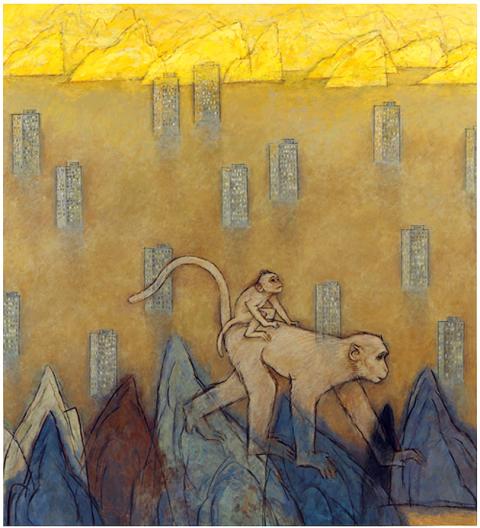The paintings by Chinese artist Zhang Hongtu (張宏圖) are informed by the landscape (山水, shanshui or “mountain water”) tradition of ink painting, with impressionist-inspired coloring. With Shanshui Today (山水今天), a solo show, he adds monkeys as a metaphor (of what, he refuses to say). A comment on evolution? A nod toward Journey to the West (西遊記)? Who knows? Zhang has said, however, that the primates are somehow connected to his concerns for our eroding environment.
■ Tina Keng Gallery (大未來耿畫廊), 15, Ln 548, Ruiguang Rd, Taipei City (台北市瑞光路548巷15號). Open Tuesdays to Sundays from 10am to 7pm. Tel: (02) 2659-0798
■ Opening reception on Saturday at 4:30pm. Until May 29

Photo Courtesy of Tina Keng Gallery
Colorful is a new series of painted wooden sculptures of women by Ai Haibara that, as you might have guessed, are quite colorful. According to the artist, the rainbow of colors serves as a symbol for the bearable lightness of being.
■ Butchart Contemporary Art Space (布查當代藝術空間), 155, Linong St Sec 2, Taipei City (台北市立農街二段155號). Open daily from 11am to 9pm. Tel: (02) 2820-9920
■ Until April 17
Capital Art Center is currently holding a retrospective exhibit on the life and work of watercolor artist and adventurer Max Liu (劉其偉). Liu’s paintings are informed by his extensive travels in South America and Southeast Asia and range from realistic nudes to cubist totemic emblems, both of which are based on his study of primitive art and culture at home and abroad.
■ Capital Art Center (首都藝術中心), 2F, 343, Renai Rd Sec 4, Taipei City (台北市仁愛路四段343號2樓). Open Tuesdays to Sundays from 10am to 7pm. Tel: (02) 2775-5268
■ Until April 22
The inkstone has a long and storied history in Chinese culture and was developed and refined along with the evolution of writing tools. The Beauty of Natural Stone Markings of the Duan Inkstone (端硯石品之美) provides a glimpse of this style of inkstone, including its forms, decorative motifs and techniques of carving. The 55 inkstones on display are variously engraved with flying dragons, flowers and birds, figures and mountain decorations — all in sublime detail.
■ National Museum of History (國立歷史博物館), 49 Nanhai Rd, Taipei City (台北市南海路49號). Open Tuesdays to Sundays from 10am to 6pm. General admission is NT$30. Tel: (02) 2361-0270
■ Until May 1
Plant of the Deep Sea (深海植物) is a solo exhibit by Japanese ceramicist Aya Murata. Murata’s ceramic sculptures are languidly surreal, somewhat spiky science-fiction studies of plant life rendered in aquamarine blues and greens.
■ Yingge Ceramics Museum (鶯歌陶瓷博物館), 200 Wenhua Rd, Yingge District, New Taipei City (新北市鶯歌區文化路200號). Open daily from 9:30am to 5pm, closes at 6pm on Saturdays and Sundays. Tel: (02) 8677-2727
■ Until April 24
Eslite Gallery is holding a double exhibition of Japanese artists Kazuna Taguchi and Teppei Kaneuji. Taguchi’s work in Gray, Mosaicism blurs the boundaries between painting and photography. She collects images from fashion magazines and the Internet, assembles them into a montage, renders it as a painting, and then photographs the painting. Kaneuji’s two-dimensional and three-dimensional installations and collages in Ghost in the City Lights reflect on dichotomies such as the urban and rural, light and shadow and illusion and reality.
■ Eslite Gallery (誠品畫廊), 5F, 11 Songgao Rd, Taipei City (台北市松高路11號5樓). Open Tuesdays to Sundays from 11am to 7pm. Tel: (02) 8789-3388 X1588
■ Until April 24

The canonical shot of an East Asian city is a night skyline studded with towering apartment and office buildings, bright with neon and plastic signage, a landscape of energy and modernity. Another classic image is the same city seen from above, in which identical apartment towers march across the city, spilling out over nearby geography, like stylized soldiers colonizing new territory in a board game. Densely populated dynamic conurbations of money, technological innovation and convenience, it is hard to see the cities of East Asia as what they truly are: necropolises. Why is this? The East Asian development model, with

June 16 to June 22 The following flyer appeared on the streets of Hsinchu on June 12, 1895: “Taipei has already fallen to the Japanese barbarians, who have brought great misery to our land and people. We heard that the Japanese occupiers will tax our gardens, our houses, our bodies, and even our chickens, dogs, cows and pigs. They wear their hair wild, carve their teeth, tattoo their foreheads, wear strange clothes and speak a strange language. How can we be ruled by such people?” Posted by civilian militia leader Wu Tang-hsing (吳湯興), it was a call to arms to retake

Desperate dads meet in car parks to exchange packets; exhausted parents slip it into their kids’ drinks; families wait months for prescriptions buy it “off label.” But is it worth the risk? “The first time I gave him a gummy, I thought, ‘Oh my God, have I killed him?’ He just passed out in front of the TV. That never happens.” Jen remembers giving her son, David, six, melatonin to help him sleep. She got them from a friend, a pediatrician who gave them to her own child. “It was sort of hilarious. She had half a tub of gummies,

The wide-screen spectacle of Formula One gets a gleaming, rip-roaring workout in Joseph Kosinski’s F1, a fine-tuned machine of a movie that, in its most riveting racing scenes, approaches a kind of high-speed splendor. Kosinski, who last endeavored to put moviegoers in the seat of a fighter jet in Top Gun: Maverick, has moved to the open cockpits of Formula One with much the same affection, if not outright need, for speed. A lot of the same team is back. Jerry Bruckheimer produces. Ehren Kruger, a co-writer on Maverick, takes sole credit here. Hans Zimmer, a co-composer previously, supplies the thumping